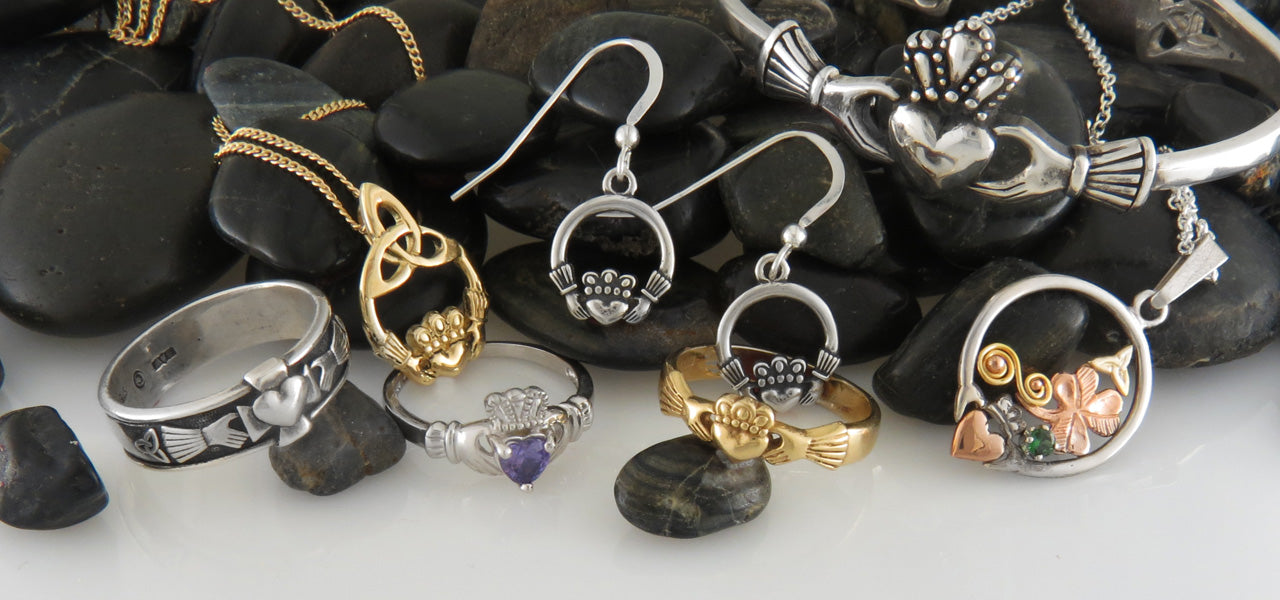- Jewelry
- Crosses
- Rings
- Mens
- Claddagh
- Wedding
- Personalized Jewelry
- John Urban Jewelry
- Sale
- Gift Certificates
- About Us

Claddagh Rings were very commonly used in the area around Galway since the late 17th century. The Claddagh is a fishing village on the outskirts of Galway City. It was a local fashion, which although it began to get wider notice in the early 20th century, was never really a part of the Celtic Revival. Towards the end of the 20th century there was an explosion of interest in the Claddagh Ring, both as jewelry and as an icon of Irishness that now adorns many other objects from pub signs to grave stones. In more recent years it has been embellished with interlace designs and combined with other Celtic and Irish symbols, but this is a very recent phenomenon that corresponds with the worldwide expansion in popularity of the Claddagh ring as an emblem of Irish identity.
$350.00
Claddagh and Trinity knot Pendant in 14K Yellow, Rose or White Gold Shown on a Yellow...
$435.00
The 14K Gold Claddagh earrings are available in yellow, white, or rose gold. The heart,...
$45.00
Trinity Claddagh Pendant in Sterling Silver. Shown on a Cable Chain. View Available Chains Item...
$75.00
Trinity Claddagh Earrings in Sterling Silver. The Heart symbolizes Love, the Crown symbolizes Loyalty, and the Hands...
$310.00
The Claddagh Celtic cross pendant shown here in 14K yellow gold is an original design...
$52.00
These Claddagh Earrings are sterling silver and available in your choice of 3 sizes, Small,...
$75.00
Sterling Silver Claddagh & Shamrock Earrings The heart, hands and crown of the fabled Irish...
$50.00
The Claddagh Celtic cross pendant shown here in sterling silver is an original design by...
$447.30 $497.00
Gold and Sterling Silver Claddagh Pendant and Earring Set available with or without 2mm Tsavorite.Sterling Silver...
$200.00
This Claddagh Pendant is available in your choice 14K Yellow, Rose or White Gold. Available...
$235.00
Gold and Sterling Silver Claddagh PendantSterling Silver frame with 18K Yellow and 14K Rose Gold details.Available...
$35.00
Claddagh Pendant in Sterling Silver The heart, hands and crown of the fabled Irish Claddagh...
$45.00
Sterling Silver Claddagh & Shamrock Pendant Shown on a Cable Chain. The heart, hands and...
Sold Out
This Claddagh Pendant is available in 14K Yellow Gold set with three 1.7mm diamonds in...
$88.20 $98.00
Sterling Silver Trinity Claddagh Pendant. Your choice of post or wire drop triquetra (trinity knot) earrings. Shown...
$250.00
Gold and Sterling Silver Celtic Earrings with or without Tsavorite.A sterling frame with 14K Rose and...
$65.00
This sterling silver bangle style charm bracelet is available with 6 different charms. Add 1...
$79.00
The Claddagh Celtic Cross pendant shown here in sterling silver is an original design by...
Sold Out
Two piece ring set in 14K Rose Gold that represents an abstract claddagh ring. One...
$675.00
Celtic heritage Claddagh ring available in 14K Yellow, Rose, and White gold. The heart, hands and...
$45.90 $54.00
Sterling Silver circular pendant with a Claddagh at the base. This pendant comes on an 18"...
$980.00
One of a kind 14K yellow gold Claddagh pendant with rose and white gold details...
$710.00
Chevron stacking band in 14K White Gold, designed to fit your R98 interlocking wedding set...
$75.00
Simulated Birthstone set in Sterling Silver Claddagh Ring. All months are available in sizes 5...
$124.20 $138.00
Sterling Silver Claddagh and Shamrock Pendant and Earrings Set The heart, hands and crown of...